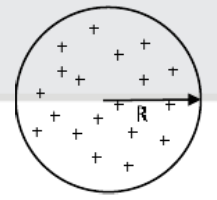An ideal gas equation can be written as P=ρRTM0 where ρ and M are resp.
mass density, mass of gas
number density, molar mass
mass density, molar mass
number density, mass of gas
The correct Answer is:C
To solve the question regarding the ideal gas equation expressed as P=ρRTM0, we need to identify what ρ and M0 represent.
1. Understanding the Ideal Gas Law:
The ideal gas law is typically expressed as:
PV=nRT
where P is the pressure, V is the volume, n is the number of moles, R is the universal gas constant, and T is the temperature in Kelvin.
2. Relating Moles to Mass:
The number of moles n can be expressed in terms of mass m and molar mass M:
n=mM
Substituting this into the ideal gas law gives:
PV=mMRT
3. Rearranging the Equation:
Rearranging the equation to express pressure P:
P=mRTMV
4. Defining Density:
The density ρ of the gas is defined as:
ρ=mV
Substituting this definition of density into the pressure equation gives:
P=ρRTM
5. Identifying ρ and M0:
In the equation P=ρRTM0, we can compare it with the derived equation P=ρRTM. From this comparison:
- ρ represents the mass density of the gas.
- M0 corresponds to the molar mass (or molecular mass) of the gas.
Final Answer:
- ρ is the mass density of the gas.
- M0 is the molar mass (or molecular mass) of the gas.
The ideal gas law is typically expressed as:
PV=nRT
where P is the pressure, V is the volume, n is the number of moles, R is the universal gas constant, and T is the temperature in Kelvin.
The number of moles n can be expressed in terms of mass m and molar mass M:
n=mM
Substituting this into the ideal gas law gives:
PV=mMRT
Rearranging the equation to express pressure P:
P=mRTMV
The density ρ of the gas is defined as:
ρ=mV
Substituting this definition of density into the pressure equation gives:
P=ρRTM
In the equation P=ρRTM0, we can compare it with the derived equation P=ρRTM. From this comparison:
- ρ represents the mass density of the gas.
- M0 corresponds to the molar mass (or molecular mass) of the gas.
- ρ is the mass density of the gas.
- M0 is the molar mass (or molecular mass) of the gas.
Topper's Solved these Questions
Similar Questions
Pressure (P) versus temperature (T) graph of an ideal gas is shown in the figure. Density of the gas at point A is ρ0 and at B is ρ. Find ρρ0.
'(##CEN_KSR_PHY_JEE_C13_E01_014_Q04##)'
View SolutionShow that the entropy of a perfect gas can be written as S=CvInp+CpInV+S0 where S0 is a constant.
View Solution
Knowledge Check
An ideal gas equation can be written as P=ρRTM0 where ρ and M are resp.
ANumber density , molar massBMass density , molar massCNumber density , mass of the gasDMass density , mass of the gasIfcpandcv are the principal specific heats of an ideal gas in cal/gm .∘C,ρ is the density, P is the pressure and T is the temperature of the gas, then Mayer's relation is
Aρ(cp−cv)=PJTBcp−cv=dPJTCcp−cv=JPρTDcp−cv=JTρPCharge density of a sphere of radius R is ρ=ρ0r where r is distance from centre of sphere.Total charge of sphere will be
 AρπeR2B2ρ0πeR2C3ρ0πeR2D4ρ0πeR2
AρπeR2B2ρ0πeR2C3ρ0πeR2D4ρ0πeR2
An ideal gas expands following a relation P2ρ= constant, where P = pressure and ρ = density of the gas. The gas is initially at temperature T and density ρ and finally its density becomes ρ3.
(a) Find the final temperature of the gas. (b) Draw the P – T graph for the process.
View SolutionIf an additional pressure Δp of a saturated vapour over a convex spherical surface of a liquid is considerably less than the vapour pressure over a plane surface, then Δp=(ρv/ρl)2α/r, where ρv and ρl) are the densities of the vapour and the liquid, α is the surface tension, and r is the radius of curvature of the surface. Using this formula, find the diameter of water droplets at which the saturated vapour pressure exceeds the vapour pressure over the plane surface by η=1.0% at a temperature t=27∘C. The vapour is assumed to be an ideal gas.
View SolutionA ball of radius R carries a positive charge whose volume density depends according only on a separation r from the ball's centre as ρ=ρ0(1−r/R), where ρ0 is a constant. Asumming the permittivites of the ball and the enviroment to be equal to unity find :
(a) the magnitude of the electric field strength as a function of the distance r both inside and outside the ball :
(b) the maximum intensity Emax and the corresponding distance rm.
View SolutionThe density inside a solid sphere of radius a is given by ρ=ρ0r, where ρ0 is the density ast the surface and r denotes the distance from the centre. Find the graittional field due to this sphere at a distance 2a from its centre.
View SolutionA non-conducting solid sphere has volume charge density that varies as ρ=ρ0 r, where ρ0 is a constant and r is distance from centre. Find out electric field intensities at following positions.
(i) r<R (ii) r≥R
View Solution
